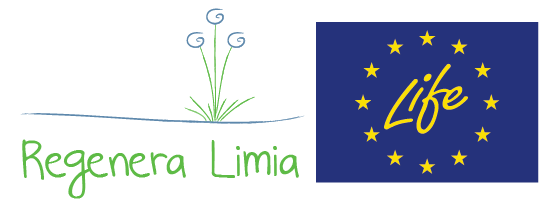
07 May RIVER REGENERATION ACTIONS FOR THE REDUCTION OF DIFFUSE POLLUTION
Here we present the results of two cases of recovery of the functions of river ecosystems and wetlands that will help to reduce diffuse pollution of agricultural origin in the river waters in the region of A Limia (Ourense). Both actions have been carried out within the framework of the LIFE REGENERA LIMIA LIFE13ENV/ES/00027 PROJECT. On the one hand, a meander has been recovered from the river Limia, cancelled during the drying up of the Lagoa de Antela in the 50s in As Veigas de Ponteliñares (Rairiz, Ourense), in order to improve its capacity to retain and assimilate nutrients; to this end, communication has been reopened with the current Limia riverbed at both ends of the blinded meander and the revegetation of its banks has been strengthened. On the other hand, efforts have been made to recover and integrate into the hydrological cycle of the Laguna de Antela Channel two ponds of old abandoned sandstone, within the A Limia SEPA zone (ES010ZEOPAES0000436), to reconvert them into a lagoon system capable of increasing the capacity for self-purification and assimilation of nutrients from the fluvial course; for this purpose, three artificial floating islands with implantation of herbaceous/busy vegetation of the surroundings were placed in the lagoon. In both cases, despite abnormally dry climatic conditions, a substantial improvement in habitats for flora and fauna species has been achieved, as well as a trend towards a reduction in pollution that will have to be confirmed in the future.

Artificial Island Rafts
Through the LIFE REGENERA LIMIA Project, co-financed by the European Union, several solutions are being implemented with demonstrative character in the Region of A Limia (Ourense) focused on solving the environmental problem of the deterioration of the water masses in the Limia River basin due to the excess of nutrients, which contribute to the eutrophication of the As Conchas reservoir located downstream.
The main objective is to demonstrate the viability and efficiency of an innovative approach that integrates preventive measures and regeneration of a highly modified fluvial system in a region with a high agro-livestock concentration, contributing to meet the environmental objectives of the Water Framework Directive.
The experiences comprise two actions of the Life project and were formulated with the objective of demonstrating that the environmental recovery of modified fluvial channels and the regeneration and reconnection of lagoon systems are viable options that contribute to reducing the presence of nutrients in the water and, consequently, eutrophication, while at the same time recovering local ecosystems, which are of special importance in spaces included in the Natura 2000 Network.
- Act of recovery and rehabilitation of old flood plains of the Limia for the reduction of the presence of nutrients in the waters by natural processes through:
– The connection of the current Limia channel with an old annulled meander.
– Plant and hydromorphological restoration and integration
2. Recovery of lagoons from old gravel pits as naturalised artificial wetlands to reduce the presence of nutrients in the water by natural processes:
– The hydrological connection of ponds with the Canal de la Laguna de Antela.
– Plant restoration and integration and placement of macrophyte islands.
The evolution of water quality parameters and bioindicators is currently being monitored and a transfer plan is planned to allow the application of the results of the project to other regions with similar situations.
Read the full article : Revista Ambienta
